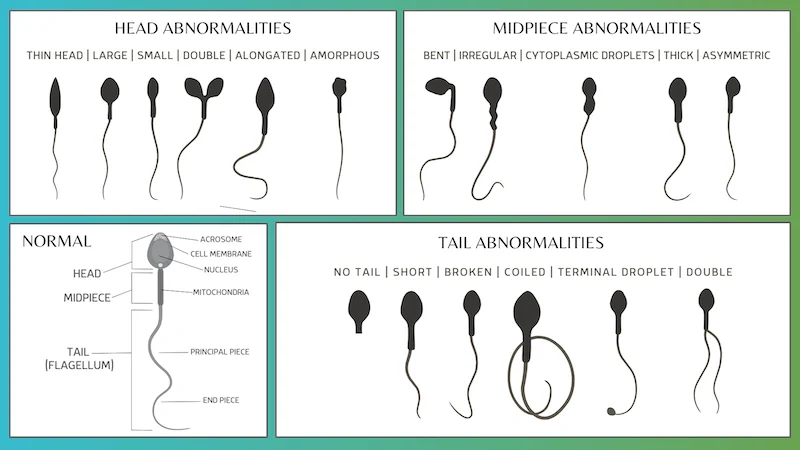Understanding Sperm Count, Morphology, and Motility
When it comes to understanding male fertility, several factors play a crucial role. Among these, sperm count, morphology, and motility stand out as primary indicators of a man's ability to contribute to conception. These terms, often discussed in fertility clinics and significant in the analysis of semen quality, can provide profound insights into male reproductive health.
Sperm Count: The Starting Point
Sperm count refers to the number of sperm cells present in a specific volume of semen. It's a foundational aspect of male fertility, as the quantity of sperm in an ejaculate directly impacts the chances of fertilizing an egg. A low sperm count, a condition known as oligospermia, can signify reduced fertility or, in some instances, infertility. Conversely, a count that's too high can also indicate issues, such as infections. The ideal sperm count for conception is about 15 million sperm per milliliter or more.
Exploring Sperm Morphology: Shape Matters
While numbers are significant, they aren't everything. The shape of the sperm, known as morphology, is equally important. Morphology refers to the size and shape of sperm, and it's critical because it can affect the sperm's ability to reach and penetrate an egg. Normal sperm have an oval head and a long tail, which work together to propel the sperm efficiently toward the egg.
Abnormal sperm morphology (teratospermia) includes defects such as a large or misshapen head, an abnormal midsection, or a crooked or double tail. These defects might impair the sperm's ability to navigate the female reproductive system or penetrate an egg if they do reach it. The percentage of sperm that have a normal shape after ejaculation is thus a key aspect of semen analysis.

The Role of Sperm Motility: Speed and Direction
However, even if a man has a high sperm count and good morphology, the sperm must be able to move properly — this is where sperm motility comes into play. Motility describes the ability of sperm to move efficiently and is categorized into two groups: progressive motility and non-progressive motility.
Progressive motility refers to sperm that move in a straight line or large circles, while non-progressive motility refers to sperm that do not travel in straight lines or that swim in very tight circles. For conception to occur, sperm must exhibit proper motility to travel through the woman's reproductive tract to reach and fertilize the mature egg. Poor motility (asthenozoospermia) means the sperm struggle to navigate towards the egg, which can be caused by factors like elevated testicular temperature, infection, or exposure to toxic substances.
Interconnection: Count, Morphology, and Motility
These three parameters don't work in isolation; they're interconnected. A semen analysis that shows issues in all three areas (oligoasthenoteratozoospermia) presents a challenging scenario for natural conception and might necessitate advanced reproductive techniques. It's a delicate balance — a high sperm count can offset poor morphology or motility, but excellent motility doesn't make up for a very low sperm count.
Factors Influencing Sperm Health
Several factors can influence sperm count, morphology, and motility. These include lifestyle choices (such as smoking, alcohol consumption, and drug use), environmental exposure to chemicals, stress, and even tight clothing that increases scrotal temperature. Medical issues, like varicoceles (swollen veins in the scrotum) or hormonal imbalances, can also affect sperm health.
Improving Your Sperm Health
Fortunately, many steps can improve sperm health: maintaining a healthy weight, eating a balanced diet, managing stress, exercising regularly, and avoiding exposure to toxins. Additionally, vitamins and supplements, like Vitamin C, Vitamin D, zinc, and folic acid, have been shown to improve sperm health.
When to Seek Help
While understanding these terms and the conditions they represent is important, it's equally crucial to know when to seek professional help. If a couple has been trying to conceive for a year or more (or six months if the woman is over 35) without success, it's prudent to consult a healthcare provider. They might recommend a semen analysis to evaluate these crucial parameters.
Sperm Health
Sperm count, morphology, and motility are critical pillars of male fertility, each playing a unique role in the conception process. Understanding what they mean and how they impact fertility is the first step for any man looking to start a family. By taking proactive steps to enhance sperm health and seeking help when necessary, men can better navigate the complex journey toward fatherhood.
- Protecting Your Health: Choosing A Sperm Bank Over Natural Insemination
- Hatching a Plan: Learning The Basics About Assisted Hatching in IVF
- Navigating GYN Surgery Before Artificial Insemination
- PGT Testing and Its Role in IVF Treatment
- The Ultimate Guide To Where You Can Donate Sperm In All 50 States

